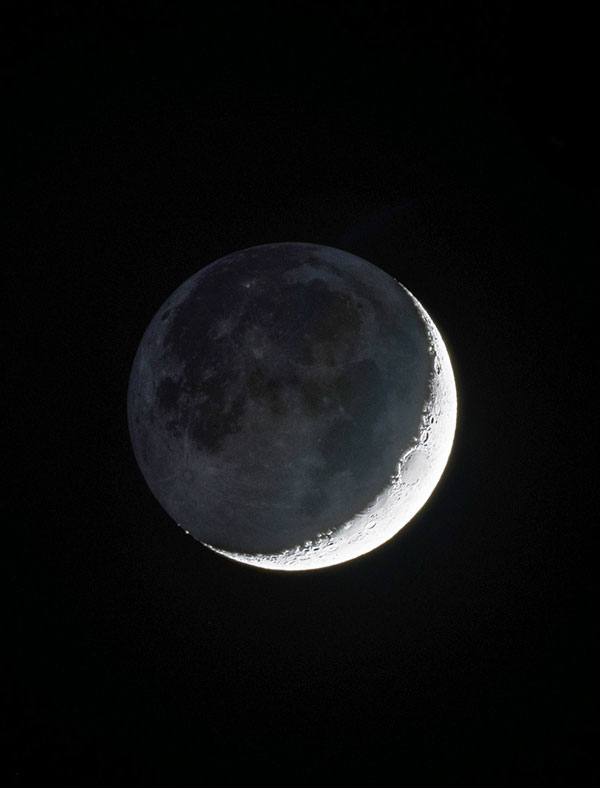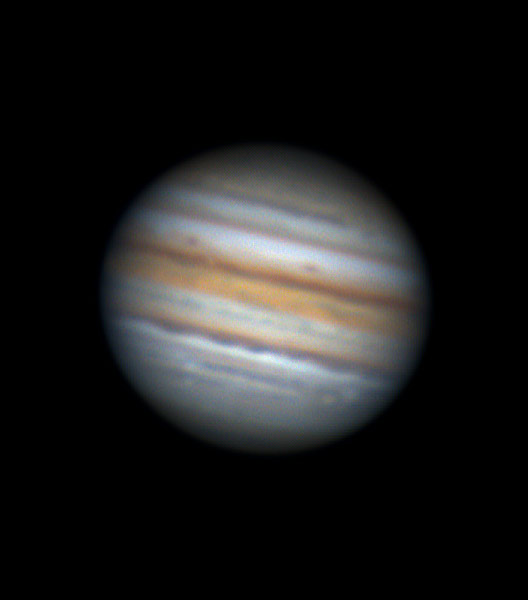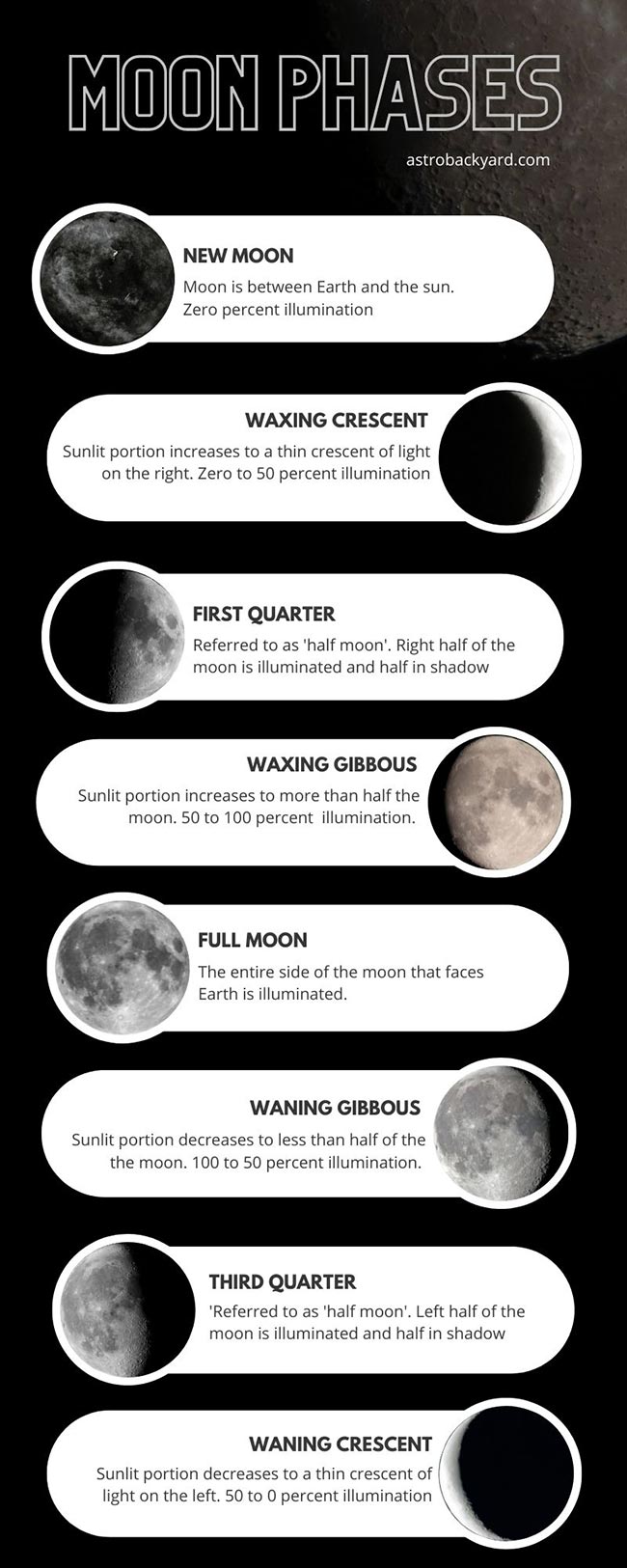Understanding Moon Phases
The moon goes through a cycle of phases each month which changes our view of the moon based on its position in relation to the Earth and the Sun. The moon phase shows the illuminated portion of the moon that is being lit by the Sun.
There are a total of eight moon phases:
- New moon
- Waxing Crescent
- First quarter
- Waxing Gibbous
- Full moon
- Waning Gibbous
- Last (third) quarter moon
- Waning Crescent
A total of eight moon phases | Time and date
The above information is per the Northern Hemisphere. In the Southern Hemisphere, the opposite sides appear to wax or wane.
Current Moon Phase:
Below, is a calendar showing the current moon phase for this month. You can cycle through different months (and years) to see the date of future full moons.
You can also use Today’s Moon Phase from Moon Giant. This will tell you the current moon cycle for today’s date.
You can also use the following tool to see the current moon phase for today’s date. This widget was provided by In-The-Sky.org, a website that includes many astronomy tools including a night sky guide and an interactive planetarium.
The Moon’s Orbit
It may help to know a little about the moon’s orbit to understand what is happening during each of the moon phases.
It takes the moon the same amount of time to orbit the Earth as it does to complete a full rotation on its axis (i.e. approximately 27 Earth days). This orbit has been affected by the Earth’s gravitational pull which has helped to slow the moon’s orbit causing the moon and Earth to be synchronized.
Due to this synchronization, we only ever see the ‘near side’ of the moon from Earth, which is only half of the lunar total surface. The amount of near side that is seen, depends on the amount of available sunlight.
The near side of the Moon as seen from Earth.
What causes the Moon Phases?
As mentioned above, the moon goes through a cycle of phases each month as it orbits Earth and each phase is dependent on the moon’s position in relation to the Sun.
The moon phase we see from Earth is the portion of the moon that is lit up by the Sun, which can range from zero percent illuminated (new moon) to 100 percent illuminated (full moon).
Changes in moon phases as the Moon orbits Earth based on sunlight | McAuliffe-Shepard Discovery Centre
This means our view of the illuminated portion of the moon changes as the moon orbits around Earth, working its way through the different moon phases.
For example, in the new moon phase, the moon is a complete shadow. As the moon continues to orbit Earth, the visible area grows (i.e. waxes) to a fully illuminated moon. The phases will then reverse where the visible area decreases (i.e. wanes).
Moon Phases in Order
As mentioned above, the moon cycles through eight phases.
New moon:
The moon is between Earth and the Sun, the moon’s shadow faces Earth.
- Moon phase type: Primary
- Percentage of Illumination: Zero percent
- Description: We cannot see the moon
It is called a “new moon” because it marks the beginning of a new lunar cycle. During this phase, the Sun and moon are in conjunction and are aligned on the same side of the Earth.
During the new moon phase, the moon appears completely dark as we are facing its shadowed side, which is not illuminated by direct sunlight. This is the best time to observe and photograph deep-sky objects.
Waxing Crescent:
- Moon phase type: Intermediate
- Percentage of Illumination: Zero to 50 percent
- Description: a thin crescent of light on the right
A waxing crescent moon with Earthshine visible.
The waxing crescent moon phase occurs between the new moon and the first quarter phases. This phase showcases a beautiful crescent-shaped moon, appearing on the right side (in the Northern Hemisphere).
As each day passes, the illuminated area on the moon gradually widens, covering more of the moon’s surface until the first quarter phase.
First-quarter:
Moon is at a right angle with respect to the Sun from Earth.
- Moon phase type: Primary
- Percentage of Illumination: 50 percent
- Description: the right side is illuminated
The first-quarter moon phase can be a bit confusing to beginners. It is named this because, at this point, the moon has completed approximately one-quarter of its orbit around the Earth.
However, from our perspective, half of the moon’s surface is illuminated (not a quarter). Some people refer to the first and last quarter moon phases as ‘Half Moon’.
Waxing Gibbous:
- Moon phase type: Intermediate
- Percentage of Illumination: 50 to 100 percent
- Description: halfway between a half-moon and a full moon (right side is illuminated)
The waxing gibbous moon phase occurs between the first quarter and full moon phases. It is characterized by the Moon being more than half illuminated, but not yet fully.
The word “gibbous” is a Latin word that refers to a shape that is convex or bulging outward on one side, resembling a hump or a rounded curve.
Full moon:
The moon is on the opposite side of Earth from the Sun, the illuminated side faces Earth.
- Moon phase type: Primary
- Percentage of Illumination: 100 percent
- Description: the entire moon is illuminated
During a “full moon”, the entire disk of the moon appears to be illuminated from our vantage point on Earth. The Sun and Moon are in opposition, positioned on opposite sides of the Earth.
If the full Moon’s position aligns correctly with the Sun and Earth, it can pass through the Earth’s shadow, resulting in a lunar eclipse.
Each month’s full moon has a different name. For example, the full moon in September is known as the “harvest moon”.
Waning Gibbous:
- Moon phase type: Intermediate
- Percentage of Illumination: 100 to 50 percent
- Description: halfway between a half-moon and a full moon (left side is illuminated)
The waxing gibbous moon phase takes place between the full moon and the last quarter. It depicts the Moon when it is more than half illuminated, but not completely.
At the beginning of this stage in the Northern Hemisphere, we see a nearly fully illuminated disk, except for a small sliver on the right side that remains in darkness.
Last quarter moon:
The moon is at a right angle with respect to the Sun from Earth.
- Moon phase type: Primary
- Percentage of Illumination: 50 percent
- Description: the left side is illuminated
The last quarter moon phase is named this because the moon has now completed approximately three-quarters of its orbit.
In the Northern Hemisphere, the left half of the moon is lit. Some people refer to this moon phase as the “Third Quarter”.
Waning Crescent:
- Moon phase type: Intermediate
- Percentage of Illumination: 50 to zero percent
- Description: a thin crescent of light on the left
The waning crescent moon phase falls between the last quarter and the new moon phases. At the beginning of this stage (in the Northern Hemisphere) the moon’s entire left side is almost fully illuminated.
As the days pass, the illuminated area gradually diminishes, covering less and less of the Moon’s surface until it appears as a very thin crescent on the left side.
The best time to view the moon in its late waning crescent stages is before sunrise when the sky is still dark in the morning.
The dates and times of these phases change each month given the amount of time it takes the Moon to orbit Earth (27 days) and the approximate time it takes to complete one cycle of phases (29.5 days), known as a synodic month.
The intermediate phases last, on average, a quarter (i.e. 7.4 days) of the synodic month while the long duration between full moon to new moon (or vice versa) lasts approximately 15 days.
New Moon and Astrophotography
If you are an astrophotographer, knowing the moon’s current phase is not new to you. A full moon can make astrophotography difficult as the moon reflects bright sunlight into the sky, washing out faint deep-sky objects.
It can also create less contrast and detail in the images you capture during a full moon. For these reasons, your best opportunity for astrophotography is on a clear night during the new moon.
Moonlight lighting up my backyard during a full moon.
Astrophotography during a full moon is possible but you will need to make some changes to your gear and the targets you shoot.
For example, selecting only bright objects away from the moon, choosing star clusters over nebulae, shooting narrowband Ha, and using light pollution filters.
A full moon shines brightly through a thin layer of clouds.
Planets are much brighter than deep-sky objects like galaxies and nebulae. Large, bright planets (from our perspective on Earth) like Venus, Mars, Jupiter, and Saturn are relatively easy to photograph using modest equipment.
The nights surrounding the full moon are a great time to photograph our solar system neighbors at high magnification. Here is a picture of the planet Jupiter captured with a bright (80% illuminated) moon nearby.
Planetary astrophotography is unaffected by a bright moon.
You can use moonlight to help illuminate a nighttime landscape, creating an image that reveals stars and constellations, and a moonlit foreground below. A rising full moon presents a fantastic opportunity to capture the moon with interesting foreground details in front of it.
The hauntingly beautiful colors of a full moon through Earth’s atmosphere make for a dramatic scene. The image below was captured from a farmer’s field as a “supermoon” rose in the fall.
The full moon rises over a farmer’s field.
Related Post: How to Take Great Pictures of the Moon (with examples)
Moon Phase Calendar
There are many websites and mobile stargazing apps available today that will provide a moon phase calendar. So if you are interested in skipping the complicated mathematical formulae to determine the cycle, you may want to look at a few of these resources. There are a few listed below for reference.
The Moon: Calendar Moon Phases (Apple/Android)
Features: moonrise, moonset, moon phases, lunar days, illumination, distance, and position. Includes bonus features.
My Moon Phase – Lunar Calendar (Apple/Android)
Features: view the moon cycle for any date, see how cloudy the sky is expected to be, the moon’s distance from Earth, receive notifications when the moon reaches a particular phase etc.
Time and Date (Website)
Features: graphic depiction of moon phase for your location, including dates for the next full moon and first-quarter phases. It also breaks down the moon phases for the year into the new moon, first quarter, full moon, and third quarter for your location and provides a separate graphic showing this information.












